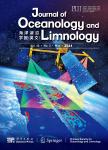Distribution and pollution assessment of trace metals in seawater and sediment in Laizhou Bay
Distribution and pollution assessment of trace metals in seawater and sediment in Laizhou Bay作者机构:Yantai Research Institute ChinaAgricultural University Key Laboratory of Marine Ecological Restoration Shandong Marine Fisheries Research Institute National Oceanographic Center
出 版 物:《Chinese Journal of Oceanology and Limnology》 (中国海洋湖沼学报(英文版))
年 卷 期:2015年第33卷第4期
页 面:1053-1061页
核心收录:
学科分类:083002[工学-环境工程] 0830[工学-环境科学与工程(可授工学、理学、农学学位)] 07[理学] 08[工学] 09[农学] 0903[农学-农业资源与环境] 0713[理学-生态学]
基 金:Supported by the Shandong Key Laboratory of Marine Ecological Restoration,Shandong Marine Fisheries Research Institute(No.201211) the National Natural Science Foundation of China(No.41206120)
主 题:Laizhou Bay trace metals arsenic sediments seawater
摘 要:Selected trace metals (Pb, Cd, Cu, Hg) and arsenic in seawater and surface sediments of Laizhou Bay were determined, to evaluate their spatial distribution, pollution risk and potential ecological risk. Concentrations of the elements were 0.56-2.07, 0.14-0.38, 12.70-18.40, 0.014-0.094, and 1.13- 2.37 μg/L in the seawater and 8.94-32.2, 0.18-0.67, 4.51-30.5, 0.006-0.058, and 5.75-15.3 mg/kg in sediments for Pb, Cd, Cu, Hg and As, respectively. High concentrations of the trace metals and arsenic in seawater and surface sediments were generally observed near the fiver estuary. The pollution risk result of the elements showed that Cu was the prominent trace metal pollutant in seawater, followed by Hg, Pb, Cd and As. The metal complex pollution index in seawater was at a medium level. The most important trace metal pollutant in sediments was Cd, followed by As, Cu, Pb, and Hg. Our pollution assessment suggests that trace metal pollution in Laizhou Bay sediments was at a low level. The potential ecological risk was also low in surface sediment.



